- Home
- About
- Map
- Trips
- Bringing Boat West
- Migration West
- Solo Motorcycle Ride
- Final Family XC Trip
- Colorado Rockies
- Graduates' XC Trip
- Yosemite & Nevada
- Colorado & Utah
- Best of Utah
- Southern Loop
- Pacific Northwest
- Northern Loop
- Los Angeles to NYC
- East Coast Trips
- Martha's Vineyard
- 1 Week in Quebec
- Southeast Coast
- NH Backpacking
- Martha's Vineyard
- Canadian Maritimes
- Ocracoke Island
- Edisto Island
- First Landing '02
- Hunting Island '02
- Stowe in Winter
- Hunting Island '01
- Lake Placid
- Chesapeake
- Provincetown
- Hunting Island '00
- Acadia in Winter
- Boston Suburbs
- Niagara Falls
- First Landing '99
- Cape Hatteras
- West Coast Trips
- Burning Man
- Utah Off-Roading
- Maui
- Mojave 4WD Course
- Colorado River Rafting
- Bishop & Death Valley
- Kauai
- Yosemite Fall
- Utah Off-Road
- Lost Coast
- Yosemite Valley
- Arizona and New Mexico
- Pescadero & Capitola
- Bishop & Death Valley
- San Diego, Anza Borrego, Joshua Tree
- Carmel
- Death Valley in Fall
- Yosemite in the Fall
- Pacific Northwest
- Utah Off-Roading
- Southern CA Deserts
- Yosemite & Covid
- Lake Powell Covid
- Eastern Sierra & Covid
- Bishop & Death Valley
- Central & SE Oregon
- Mojave Road
- Eastern Sierra
- Trinity Alps
- Tuolumne Meadows
- Lake Powell Boating
- Eastern Sierra
- Yosemite Winter
- Hawaii
- 4WD Eastern Sierra
- 4WD Death Valley +
- Southern CA Deserts
- Christmas in Tahoe
- Yosemite & Pinnacles
- Totality
- Yosemite & Sierra
- Yosemite Christmas
- Yosemite, San Diego
- Yosemite & North CA
- Seattle to Sierra
- Southwest Deserts
- Yosemite & Sierra
- Pacific Northwest
- Yosemite & South CA
- Pacific Northwest
- Northern California
- Southern Alaska
- Vancouver Island
- International Trips
- Index
- Tips
- Books
- Photos/Videos
- Search
- Contact
Mono Lake and Travertine Hot Springs (Bridgeport), CA
Monday, July 25, 2016 - 2:15pm by Lolo
20 miles and 0.5 hours from our last stop - 3 night stay
Travelogue
Arrival and Travertine Hot Springs
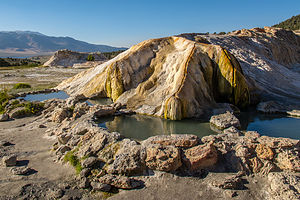 Travertine Hot SpringsThe drive along the Tioga Road east to Mono Lake is dramatically beautiful, with views of Mount Dana and Mount Gibbs, Ellery and Tioga Lakes, and the Lee Vining Canyon along the way. ,I feel bad that Herb, as the one driving the motorhome down this precariously steep and twisty road, doesn’t get to appreciate the scenery. We always breathe a sigh of relief when we Mono Lake comes into view and we know we have reached flatter ground.
Travertine Hot SpringsThe drive along the Tioga Road east to Mono Lake is dramatically beautiful, with views of Mount Dana and Mount Gibbs, Ellery and Tioga Lakes, and the Lee Vining Canyon along the way. ,I feel bad that Herb, as the one driving the motorhome down this precariously steep and twisty road, doesn’t get to appreciate the scenery. We always breathe a sigh of relief when we Mono Lake comes into view and we know we have reached flatter ground.
Since it was too early to check into our campsite at Mono Vista RV Park, we decided to kill some time at the Visitor Center. I’m glad we did, because a helpful ranger told us about a remote and very unique tufa area that is only accessible by kayak (5 miles each way). In past years we have really enjoyed kayaking to Paoha Island, but we were a week too early. The island is closed each year from April 1 to August 1 to protect the nesting California gulls that leave San Francisco each spring and come here to breed. Maybe it was a good thing, because it would force us to try something new.
 Lolo hits Mono LakeBut that was tomorrow’s event, so today after checking in and dropping the motorhome off at the campground, we drove up 395 to Travertine Hot Springs in Bridgeport, our favorite natural hot spring. Being veterans of this spring, we knew enough to pass right by the partially-developed pool at the edge of the parking lot and continue down a short trail to the main pools, which are fed from water trickling over the edge of a colorful, “travertine”-stained rock formation that rises above them. Rock piles separate the water into three separate pools, with water flowing from one pool to the next, decreasing in temperature as it goes along. The rightmost pool, which has stone sides to sit on, is about 105 degrees; the middle pool also has stone sides and is about 100 degrees; and the leftmost pool has a mushy mud bottom and is about 90 degrees. All three pools were empty today, which is unusual, but perhaps the 90+ degree air temperature made the thought of sitting in hot water less appealing.
Lolo hits Mono LakeBut that was tomorrow’s event, so today after checking in and dropping the motorhome off at the campground, we drove up 395 to Travertine Hot Springs in Bridgeport, our favorite natural hot spring. Being veterans of this spring, we knew enough to pass right by the partially-developed pool at the edge of the parking lot and continue down a short trail to the main pools, which are fed from water trickling over the edge of a colorful, “travertine”-stained rock formation that rises above them. Rock piles separate the water into three separate pools, with water flowing from one pool to the next, decreasing in temperature as it goes along. The rightmost pool, which has stone sides to sit on, is about 105 degrees; the middle pool also has stone sides and is about 100 degrees; and the leftmost pool has a mushy mud bottom and is about 90 degrees. All three pools were empty today, which is unusual, but perhaps the 90+ degree air temperature made the thought of sitting in hot water less appealing.
These are not the only pools to soak in. The whole area around the springs is very active geothermally, so new springs are continuously erupting forming new pools. Herb likes to stake out his own private pool for two, so we walked across the field and found one we hadn’t seen before. It was perfect. Someone had put railroad ties along its edges to sit on, and the bottom wasn’t muddy as many of them are. Also, the views of the mountains and the town of Bridgeport below were lovely.
 Landing by remote tufasHerb loves the heat much more than I do, so he was desperately trying to keep me cool so that he could stay longer. Knowing full well that if I was miserable, he would be too, he took a rain umbrella and a bungee cord that he found in our car trunk and managed to fasten it to my beach chair. He is pretty handy, especially when motivated.
Landing by remote tufasHerb loves the heat much more than I do, so he was desperately trying to keep me cool so that he could stay longer. Knowing full well that if I was miserable, he would be too, he took a rain umbrella and a bungee cord that he found in our car trunk and managed to fasten it to my beach chair. He is pretty handy, especially when motivated.
It bought him a few hours, which we spent reading, gazing at the scenery, and occasionally soaking. Surprisingly, even 100 degree water has a cooling effect when you get out and it starts to evaporate.
Kayaking on Mono Lake
Today was our day to kayak, and thankfully the weather looked perfect - extremely calm and water like glass. Very fortunate for us, because often the winds on the lake are so strong that kayaking is strongly discouraged. Mornings are usually calmer, with winds picking up in the afternoon, but today the winds were forecast to be calm all day.
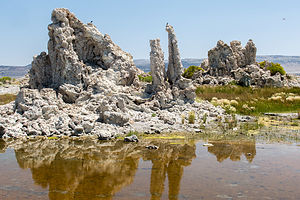 Giraffe tufasOur first order of business was getting the kayaks down from the roof of the motorhome where they’re stored – not exactly an easy feat for Herb, and one which won’t be getting any easier as we age. For now, however, it still worked, so we would put off that worry for another day.
Giraffe tufasOur first order of business was getting the kayaks down from the roof of the motorhome where they’re stored – not exactly an easy feat for Herb, and one which won’t be getting any easier as we age. For now, however, it still worked, so we would put off that worry for another day.
After loading our kayaks on the roof of our Subaru, we drove along the bumpy dirt road to Navy Beach on the southern end of the lake to launch our kayaks.
We absolutely love kayaking on Mono Lake. It is such a unique and otherworldly place. Besides being over a million years old, and probably the oldest continuously existing lake in North America, it is 2 ½ times saltier than the ocean and 80 times more alkaline.
The other unique feature of this lake is its mystical “tufa castles” formed when carbonates in the water combined with calcium from freshwater springs feeding into the lake. As the lake levels dropped over the years, these extraordinary-looking knobs, spires, and minarets became exposed. Most of the towers visible in the lake are from 200 to 900 years old and rise as high as 30 feet above the water. The largest concentration of them can be found along the southern shore of the lake at the South Tufa State Reserve, just ½ mile west of Navy Beach.
 Sand spit by remote tufasAfter launching our kayaks, we paddled east along the southern shoreline towards the remote tufa area the ranger had told us about yesterday. I much prefer staying near the shoreline than going out across open lake, because even if you aren’t, you feel like you are making progress because of the changing scenery going by. On open water, everything looks the same and you feel like you are standing still.
Sand spit by remote tufasAfter launching our kayaks, we paddled east along the southern shoreline towards the remote tufa area the ranger had told us about yesterday. I much prefer staying near the shoreline than going out across open lake, because even if you aren’t, you feel like you are making progress because of the changing scenery going by. On open water, everything looks the same and you feel like you are standing still.
Herb’s kayak is much faster than mine and he is a much stronger paddler, so I let him go ahead and just moseyed along at my own pace. I started my Strava (app that keeps track of your time and distance for various activities), so that I could monitor my progress. The ranger had told us that the tufa area was 5 miles from Navy Beach, but it turned out to be more than 6, probably because I hugged the shoreline rather than going in a straight line.
Herb was there to greet me when I finally pulled my kayak up on the deserted beach. It was so totally quiet that it felt like we were the only ones left on Earth. Our only companions were the seagulls, who should have been packing up and heading back to San Francisco about now that the breeding season was over.
 Lolo exploringOh, and of course, there were the ever present brine flies along the shoreline. It’s fun to walk up to them and watch what looks like black sand rise in a little cloud and then settle back down a few feet away. I spent a little time amusing myself herding them along the shoreline.
Lolo exploringOh, and of course, there were the ever present brine flies along the shoreline. It’s fun to walk up to them and watch what looks like black sand rise in a little cloud and then settle back down a few feet away. I spent a little time amusing myself herding them along the shoreline.
When I got tired of playing with the brine flies, we tried to find the fresh water spring and the giraffe-shaped tufas that the ranger had told us about. We found them, or more correctly Herb did, and some other very interesting ones as well.
It really was a very special and unique experience spending an afternoon here. There are not too many places you can go to anymore where you are literally miles from the next human being.
Fortunately, when we were ready to go, the winds were still calm, making our paddle back a pleasant one. All in all, we went 12.7 miles, my longest paddle to date.
Soaking in Travertine Hot Springs again, Exploring Dog Town, and dining at Whoa Nellie’s Deli
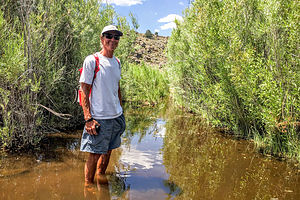 Herb fording the river to Dog TownTommy was coming back to join us today, but only as a brief overnight base camp for a backcountry rock climbing adventure in the Sawtooth Range just west of Bridgeport. He and his friend John planned to climb the Incredible Hulk, one of the biggest granite walls in the High Sierra. Just getting to the base of the climb required a 3-hour backpack in.
Herb fording the river to Dog TownTommy was coming back to join us today, but only as a brief overnight base camp for a backcountry rock climbing adventure in the Sawtooth Range just west of Bridgeport. He and his friend John planned to climb the Incredible Hulk, one of the biggest granite walls in the High Sierra. Just getting to the base of the climb required a 3-hour backpack in.
Since they would be camping out for several days, they needed a wilderness permit from the Bridgeport ranger station, which unfortunately would close before Tommy could get there. That’s why he asked me very nicely last night, whether I could pick the permit up for them since I was already in the area and it was right near Travertine Hot Springs, which he knew we enjoyed.
I didn’t have the heart to tell him that we had already been to the hot springs and had no intention of going there again, so I said, “Sure, no problem.” So, back to the springs we went, which wasn’t exactly too much of a hardship, stopping along the way to get his permit.
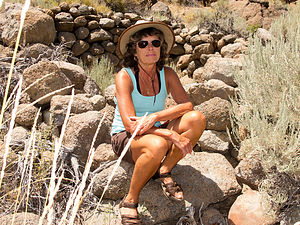 Lolo in Dog Town (ghost town)After our soak, on the drive back down 395, we pulled over by an historical marker alongside the highway that we had always been curious about. The sign read, “Dog Town,” and it was the site of the first gold rush on the slope of the Eastern Sierras, which now was just another one of the West’s deserted ghost towns.
Lolo in Dog Town (ghost town)After our soak, on the drive back down 395, we pulled over by an historical marker alongside the highway that we had always been curious about. The sign read, “Dog Town,” and it was the site of the first gold rush on the slope of the Eastern Sierras, which now was just another one of the West’s deserted ghost towns.
Since we had some time to kill before Tommy’s arrival, we decided to try to find it. We had the coordinates for where it was located and could see dirt roads on Google Maps, so we started driving the Subaru down a bumpy dirt road off the highway. It wasn’t long before the road dead ended at a stream, probably the one in which they used to pan for gold, which prevented us from going any further. Undaunted, we parked the car, waded across, and continued on foot.
It was hard to believe there was once a thriving mining camp here, because we almost missed it. All that remained of Dog Town were a few stone foundations and a single gravesite. Still, it was pretty cool to imagine what this place must have been like when it was bustling with hundreds of prospectors.
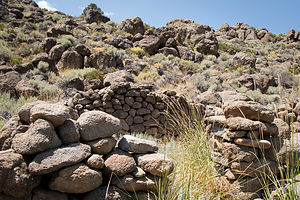 Dog TownWhat I would really recommend to anyone interested in ghost towns and California’s gold rush history is a visit to nearby Bodie State Historic Park, which we had been to last year. It is the best preserved ghost town in the West and has dozens of buildings and roads that have been preserved in a stated of “arrested decay.” It is definitely well worth a visit.
Dog TownWhat I would really recommend to anyone interested in ghost towns and California’s gold rush history is a visit to nearby Bodie State Historic Park, which we had been to last year. It is the best preserved ghost town in the West and has dozens of buildings and roads that have been preserved in a stated of “arrested decay.” It is definitely well worth a visit.
Tommy met us at the campground late afternoon, very grateful that we had been able to get his wilderness permit. We decided to go out for dinner at our favorite gas station restaurant, Whoa Nellie’s Deli, at the Mobil station near the Yosemite eastern entrance.
Don’t let the fact that it is located in a gas station fool you though, because it has quite an exotic menu and has been written up in Gourmet magazine as a gourmet oasis in what used to be a culinary wasteland. The motorhome was beginning to feel a bit like a culinary wasteland, so I was delighted to be going out on the town.
Tommy’s friend John was driving all the way down from Bend, Oregon and wasn’t expected to arrive in Lee Vining until near closing time at the Deli, so we went on ahead and ordered his food to go. Not only is the food excellent, but the views of Mono Lake from the outdoor picnic tables were phenomenal as well. John finally arrived, very hungry and appreciative for the Lobster Taquitos waiting for him.
 Dinner with Tommy at Whoa Nellie DeliBack at the campsite, Tommy and John spend a good deal of time organizing their gear – food, water, camping stuff, climbing gear, etc. It was going to be quite an adventure, and although I tried not to let on, I was a bit nervous – after all, no matter how old he gets or how accomplished he is as a climber, I am still a mother, and it is a mother’s job to worry about her young.
Dinner with Tommy at Whoa Nellie DeliBack at the campsite, Tommy and John spend a good deal of time organizing their gear – food, water, camping stuff, climbing gear, etc. It was going to be quite an adventure, and although I tried not to let on, I was a bit nervous – after all, no matter how old he gets or how accomplished he is as a climber, I am still a mother, and it is a mother’s job to worry about her young.
The next morning, they got up at 4:30, so that they could backpack in and still get in a full day of climbing. After going back to sleep for awhile, Herb and I headed out to drive to South Lake Tahoe, the final destination of our trip.
Description
Mono Lake
 Sand spit by remote tufasMono Lake is located just off Highway 395 near the town of Lee Vining, California, 13 miles east of Yosemite National Park. Mono Lake is extremely unique. First of all, at over 1 million years of age, it is one of the oldest continuously existing lakes in the continent. Secondly, it is about 2 ½ times as salty as the sea and about 80 times as alkaline. This is because Sierra streams flow into Mono Lake bringing trace amounts of salts and minerals, but the lake has no outlet other than evaporation. As a result, the concentration levels of salts and minerals keeps growing each year. Thirdly, and the main reason Mono Lake is so popular, are the hundreds of spectacular “tufa towers” that rise from the lake. These intriguing calcium-carbonate sculptures were formed beneath the water when carbonates in the water combined with calcium from freshwater springs feeding into the lake. As lake levels dropped, these extraordinary-looking knobs, spires, and minarets became exposed. Most of the towers visible in the lake are from 200 to 900 years old and rise as high as 30 feet above the water.
Sand spit by remote tufasMono Lake is located just off Highway 395 near the town of Lee Vining, California, 13 miles east of Yosemite National Park. Mono Lake is extremely unique. First of all, at over 1 million years of age, it is one of the oldest continuously existing lakes in the continent. Secondly, it is about 2 ½ times as salty as the sea and about 80 times as alkaline. This is because Sierra streams flow into Mono Lake bringing trace amounts of salts and minerals, but the lake has no outlet other than evaporation. As a result, the concentration levels of salts and minerals keeps growing each year. Thirdly, and the main reason Mono Lake is so popular, are the hundreds of spectacular “tufa towers” that rise from the lake. These intriguing calcium-carbonate sculptures were formed beneath the water when carbonates in the water combined with calcium from freshwater springs feeding into the lake. As lake levels dropped, these extraordinary-looking knobs, spires, and minarets became exposed. Most of the towers visible in the lake are from 200 to 900 years old and rise as high as 30 feet above the water.
A good place to start your visit is at the Mono Basin Scenic Area Visitor Center, located just off Highway 395, north of Lee Vining, where you will find exhibits about both the natural and human history of the Mono Basin.
One of the best places to view the tufas is at the Mono Lake Tufa State Reserve along the southern shoreline of the lake. The trailhead for the south tufa castles and Navy Beach is at the edge of the parking lot. During the summer, rangers lead walking tours 3 times a day (10am, 1pm, and 6pm), but if your not lucky enough to catch one of these, there are plenty of informative signboards along the trail. A short walk along the mile-long trail brings you to the strange and fanciful tufa castles at Navy Beach. A swim in the buoyant waters of Mono Lake is a memorable experience, as long as you are willing to step through the millions of harmless alkali flies that line the water’s edge. It’s fun to watch what at first looks like black sand part before you.
Surrounded by volcanic hills, Mono Lake is also a geologist's paradise. The two major islands in the lake are actually volcanic domes. The large black island, which the Kuzedika Indians named Negit, meaning “blue-winged goose,” erupted about 1700 years ago. The white island, which the Native Americans named Paoha, meaning “spirits of the mist,” erupted 250 years ago.
Bird watching and photography are other popular activities at Mono Lake.
Travertine Hot Springs (Bridgeport)
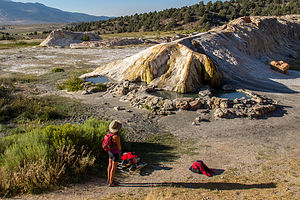 Lolo by Travertine Hot SpringsThere are many natural hot springs in the Sierras, but the Travertine Hot Springs are one of the prettiest and the easiest to get to. They are located just south of the town of Bridgeport along Route 395. To reach the springs, turn onto Jack Sawyer Road, then left again onto a marked, but somewhat rutted, dirt road.
Lolo by Travertine Hot SpringsThere are many natural hot springs in the Sierras, but the Travertine Hot Springs are one of the prettiest and the easiest to get to. They are located just south of the town of Bridgeport along Route 395. To reach the springs, turn onto Jack Sawyer Road, then left again onto a marked, but somewhat rutted, dirt road.
There are several pools at Travertine. Right next to the parking area is a developed pool, which is the hottest of the pools in the area. There were even rugs placed around it to cushion the hard surface.
A short way down the trail are the lower three pools, which are fed from water trickling over the ridge of a colorful rock formation that rises above them. The beautiful tan, cream and rust colors of the rock are the result of a form of limestone, called “travertine” that is deposited by the mineral-laden hot springs. The water flows from one pool to the next decreasing in temperature as it goes along. The first pool is about 105 degrees, while the last, which is the largest and shallowest, is only about 90 degrees.
A little past the main pools there are a few more primitive pools that are much more private. The whole area around the springs is very active geothermally, and new springs are continuously erupting.
There are wonderful views of the Sierras while you bathe in one of its pools, sitting along a rocky ledge or in the mud that lines their bottoms. The mud is slightly sulfuric and soothing to the skin.
The area is designated “clothing optional,” but most people wear bathing suits.
- ‹ previous
- 3 of 5
- next ›
Mono Lake and Travertine Hot Springs (Bridgeport) location map in "high definition"
Javascript is required to view this map.
